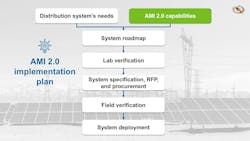IEEE Grid Edge: Using AMI 2.0 and Data Analytics to Implement the Distribution Grid of the Future
Clean energy mandates are driving utilities toward greater adoption of distributed energy resources (DERs), particularly photovoltaic distributed generation, in distribution systems.
However, distribution circuits and substations were not originally designed for the integration of variable renewable generation. As a result, the interconnection of these inverter-based DERs causes a variety of impacts on distribution system operations and planning, including voltage increases, voltage fluctuations, and reverse power flow through distribution assets.
Identifying and mitigating these impacts requires improved system monitoring and analytics. Additional impacts are caused by the increased market penetration of electric vehicles (EVs), including asset overloads, low-voltage violations, voltage and current imbalances, etc.
An advanced metering infrastructure (AMI) system combined with data analytics is a key component of a grid modernization plan to address these issues and meet the needs of the distribution grid of the future. AMI systems provide system-wide two-way remote meter reading capability that includes the smart meters, field communications, and the system head-end that interfaces with other systems such as billing, outage management, etc. Numerous analytic applications have been developed using these earlier AMI systems, typically referred to as AMI 1.0, to improve distribution systems. Many of the AMI 1.0 systems deployed in the early 2000s are reaching their end-of-life.
AMI system technologies have improved greatly over the years, and suppliers are now launching AMI 2.0 systems. While the definition of AMI 2.0 varies from one supplier to another, some common aspects include:
- Improved distribution grid modeling functionality such as meter phase detection or meter transformer grouping.
- Computing capabilities enabled at the grid edge via an installed operating system (OS) and memory within the meters, for example: subcycle waveform analysis, DER detection, etc. Some suppliers include new grid edge applications and the capability to update and/or develop and deploy new applications remotely.
- Enhanced distribution automation support enabling integration of other remote sensors such as intelligent fault current interrupters.
- Continued support for traditional metering functionality delivered in AMI 1.0 systems.
A successful AMI 2.0 plan involves business, organization, and technical collaboration to realize operational benefits. As most utilities have AMI 1.0 systems and are familiar with the system features, the challenge for AMI 2.0 is building awareness of new system capabilities from the various suppliers, the selection of use cases, use case verification, and a prioritized deployment roadmap that includes analytics. These results can be used to generate an AMI 2.0 specification to meet the utility’s defined needs.
Note that verification historically was more about meter accuracy testing, however, new test approaches such as real-time simulations are needed to verify more advanced system functions and to validate the AMI system outputs for analytics. Functional testing can be used to tune the AMI specification and plan for a pilot deployment.
These topics will be discussed during the panel session “Sharing Utility Experiences with Data Analytics and AMI” at the 2025 IEEE PES Grid Edge Technologies Conference and Exposition in San Diego on Jan. 21-23, 2025. The panel session will be moderated by David G. Hart, PhD, senior vice president of the Monitoring, Protection, Automation, and Control Business Area at Quanta Technology, and it will include Mark Carpenter, senior vice president of T&D Operations at ONCOR; Shawn Mundy, cirector of Operational Analytics & Standards at CenterPoint Energy; Juan Rodriguez, PE, MBA, PMP, vice president of Projects at LUMA Energy; and Matt Reno, PhD, Distinguished Member of Technical Staff at Sandia National Laboratories. The session will cover existing AMI 1.0 analytics applications as well as new applications utilizing AMI 2.0 developed by industry-recognized experts.
For the complete program and more information on the IEEE PES Grid Edge Technologies Conference and Exposition, visit: www.pes-gridedge.org The event will be held on January 21-23, 2025 at the San Diego Convention Center.


